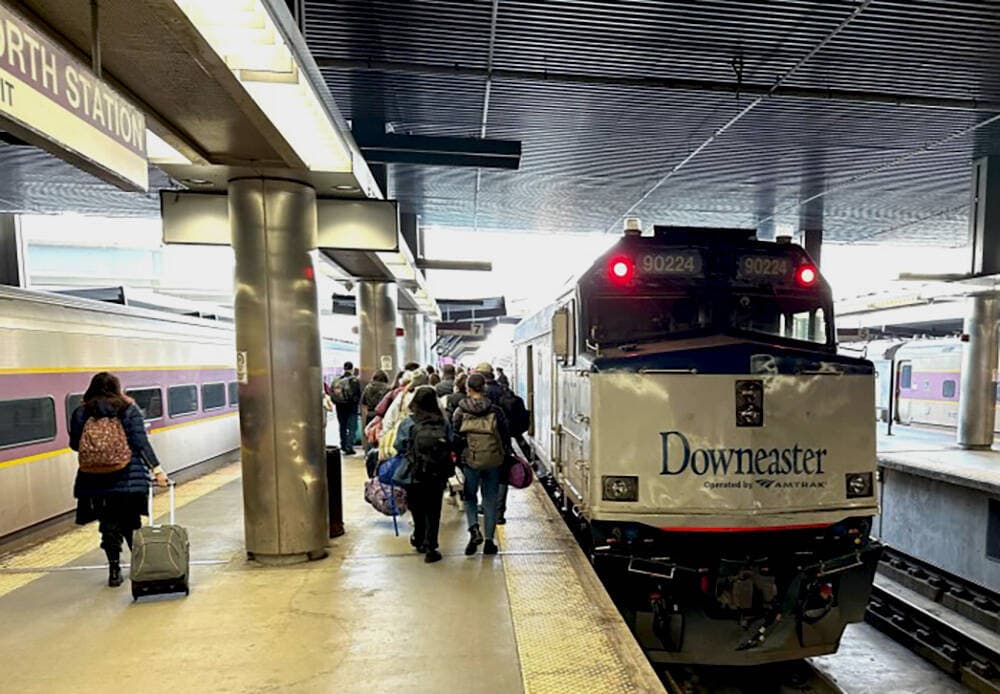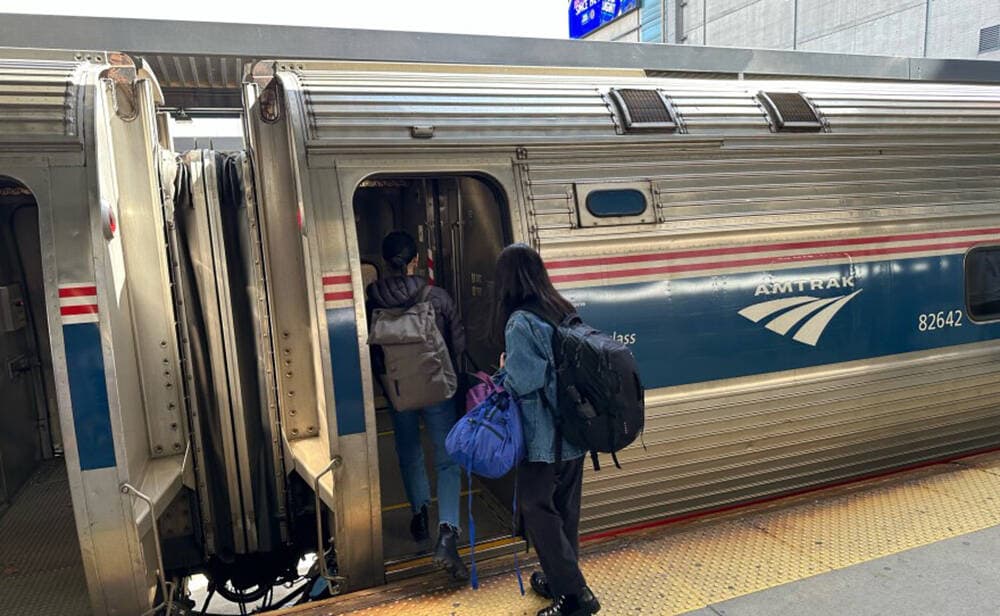Advertisement
What the East-West Rail could learn from the Downeaster
During Gov. Maura Healey's first year in office, some residents in western Massachusetts are renewing calls for faster and more frequent rail service connecting them to the eastern part of the state. One resident wondered what lessons could be gleaned from the success of the Downeaster, Amtrak's daily roundtrip service from Boston to Brunswick, Maine.

On a chilly Friday morning, Amtrak's Downeaster service was getting ready to leave Boston's North Station. Cat O'Donnell was returning home to Maine. Her employer had sent her and 28 co-workers to Boston to see a Bruins game and spend the night.
"It's convenient. We've rented a bus before and it's just not worth it," she said. "It's a much better way to travel. And we can all pick it up where we live."
Henry Schuth, of Somerville, is traveling north with his partner for a weekend away to celebrate his birthday. He said there's a good reason they chose not to drive.
"We don't have a car. That's a big one for us," he laughed. "I feel like if we had a car, it's a pain to park here. It's a pain to park in Portland and it's just easier."
The Downeaster is popular, carrying more than 400,000 passengers in the last fiscal year.
But bringing it to reality didn't happen quickly. The service was the result of a grassroots effort led by Wayne Davis. He's 88 years old now and lives in Brunswick. In the late 1980s, he led the Maine chapter of the Mortgage Bankers Association of America.
"I was tired of flying to Washington and I was on a plane that blew out a tire when it landed in Washington, and it scared the hell out of me," Davis said. "So anytime I had to go for meetings, I was driving. Anyway, I thought that's silly. We should have trains. I shouldn't have to drive to Boston to get a train."
Advertisement
Davis formed a group of likeminded people, but quickly learned that starting new passenger rail service is no small undertaking.
"It was difficult. There were so many sides to it that we hadn't thought of as the citizens' group," Davis said. "If you were going to start train service, well — where do you fuel them, where do you service them, what equipment are you going to use, and is it going to be a combination of state expense or community expense? There were so many things to think about. As I look back on it now, no wonder they thought we were all crazy."
Downeaster supporters, who formed a group called Train Riders Northeast, helped get legislation passed in Maine to establish passenger rail service. They ran ads to try to galvanize public support, but were a little optimistic about the timeline.
"You can help bring trains to Maine and the rest of northern New England by joining Trains Riders Northeast today," the ad said. "We need more volunteers and sponsors to assure that passenger trains will roll between Portland and Boston by 1993."
Service didn't start until 2001 and that was only after getting past plenty of opposition.
Charles O'Leary was the transportation commissioner for New Hampshire, which the train would need to run through. In a TV interview from back then, he mocked proponents who said they preferred taking a train to a bus.
"They say buses aren't for them. They say that there's no dining car on the bus," O'Leary said. "Well, hell ... for $86 million, I'll buy them all a lunch. I'll run in a string quartet and a little violin music. They can get a little romance on the bus."
But Maine state leaders backed the idea. Davis said that was key, and he offers some advice to those looking to start passenger rail in other places.
"If you want train service, you better have the governor behind you and you better have the commissioner of transportation," Davis said.
That's not something East-West rail supporters have been able to count on. Ben Hecksher leads Trains in the Valley, a western Massachusetts nonprofit.
"I think it's fair to say [Gov. Charlie Baker] was really not interested in the project early on in his administration. But Gov. Baker came around to supporting East-West rail at the end of his term and Gov. Healey is clearly very much in favor of moving this forward," he said.

"It's super, super important," Healey said in a March speech in Springfield. "We are committed to seeing this through, working with our local, state and federal delegation to make this happen as quickly as possible."
In her proposed budget, Healey included money for East-West rail for needed track work and the hiring of five people to focus on it.
Hecksher said the project has two things going for it now.
"You need political will and you need money. And both of those things are there in the governor, in [U.S. Rep.] Richard Neal, and the bipartisan infrastructure bill, there's billions of dollars there," he said. "There's lot of states asking for the money, but Massachusetts is lined up there to move this forward now."
Hecksher said the stars are aligned as never before for East-West rail and he's optimistic it will happen.
If he's right, passengers could be boarding a train from Boston's South Station before too long — bound for Worcester, Palmer, Springfield and Pittsfield.
This story is part of the New England News Collaborative. It was originally published by New England Public Media.